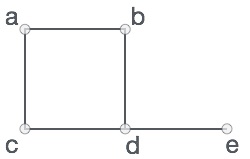Hi everyone, inside this article we will see the concept about Graphs Data Structure.
In computer science, a graph is a data structure that represents a set of objects, known as vertices or nodes, and the connections between them, known as edges.
Graphs are used to model complex relationships and structures, and are used in many different applications, including computer networks, social networks, logistics, and many more.
The interconnected objects are represented by points termed as vertices, and the links that connect the vertices are called edges.
Formally, a graph is a pair of sets (V, E), where V is the set of vertices and E is the set of edges, connecting the pairs of vertices. Take a look at the following graph −

In the above graph,
V = {a, b, c, d, e}
E = {ab, ac, bd, cd, de}
Important Terms of Graphs Data Structure
Here are some important terms related to graphs data structure:
- Vertex: A vertex, or node, is a fundamental unit in a graph. It represents an object or entity that can be connected to other vertices by edges.
- Edge: An edge is a connection between two vertices in a graph. It represents a relationship or connection between the two vertices.
- Weight: The weight of an edge is a value that represents the cost or distance associated with traversing the edge.
- Degree: The degree of a vertex is the number of edges that connect to it. In an undirected graph, the degree is the number of edges that connect to the vertex. In a directed graph, the degree is the sum of the in-degree and out-degree of the vertex.
- Path: A path is a sequence of vertices that are connected by edges. It represents a route or a way to traverse the graph from one vertex to another.
- Cycle: A cycle is a path that starts and ends at the same vertex, and contains at least one edge.
- Connected graph: A connected graph is a graph where there is a path between every pair of vertices.
- Component: A component is a subset of vertices in a graph that are connected to each other, but are not connected to vertices in other components.
- Adjacency matrix: An adjacency matrix is a square matrix that represents a graph, where the rows and columns correspond to the vertices, and the entries indicate whether an edge exists between two vertices.
- Adjacency list: An adjacency list is a data structure that represents a graph, where each vertex is associated with a list of its neighbouring vertices.
Understanding these terms is essential for working with graphs data structure and implementing algorithms that operate on them.
Types of Graphs Data Structure
There are several types of graphs, including:
- Undirected graphs: In an undirected graph, the edges have no direction, and the relationship between vertices is symmetric.
- Directed graphs: In a directed graph, the edges have a direction, and the relationship between vertices is asymmetric.
- Weighted graphs: In a weighted graph, the edges have weights or costs that reflect the relationship between the vertices they connect.
- Bipartite graphs: In a bipartite graph, the vertices can be divided into two disjoint sets, with edges only connecting vertices from different sets.
- Tree graphs: In a tree graph, the vertices are connected in a hierarchical structure, with each vertex having at most one parent and zero or more children.
- Complete graphs: In a complete graph, every pair of vertices is connected by an edge.
Graphs can be represented using several different data structures, including adjacency lists, adjacency matrices, and edge lists. Various algorithms can be applied to graphs, including traversal algorithms, shortest path algorithms, and minimum spanning tree algorithms.
Graphs are an important tool in computer science, and understanding their properties and algorithms is essential for many applications, including network analysis, routing, and machine learning.
Basic Operations of Graphs Data Structure
The basic operations of graphs data structure include:
- Adding a vertex: This operation adds a new vertex to the graph.
- Adding an edge: This operation adds an edge between two vertices of the graph.
- Removing a vertex: This operation removes a vertex from the graph, along with all its associated edges.
- Removing an edge: This operation removes an edge from the graph.
- Traversing the graph: This operation visits all the vertices in the graph and performs some operation on each of them.
- Finding the shortest path: This operation finds the shortest path between two vertices in the graph, based on the weights of the edges.
- Finding the minimum spanning tree: This operation finds a subset of the edges that connect all the vertices in the graph with the minimum possible total edge weight.
- Checking if the graph is connected: This operation checks if the graph is connected, meaning that there is a path between every pair of vertices.
- Checking if the graph is acyclic: This operation checks if the graph has no cycles, meaning that there is no path that starts and ends at the same vertex.
These basic operations are the building blocks for more complex algorithms that operate on graphs, and they are essential for implementing many common graph algorithms.
We hope this article helped you to understand about Graphs Data Structure in a very detailed way.
Online Web Tutor invites you to try Skillshike! Learn CakePHP, Laravel, CodeIgniter, Node Js, MySQL, Authentication, RESTful Web Services, etc into a depth level. Master the Coding Skills to Become an Expert in PHP Web Development. So, Search your favourite course and enroll now.
If you liked this article, then please subscribe to our YouTube Channel for PHP & it’s framework, WordPress, Node Js video tutorials. You can also find us on Twitter and Facebook.
